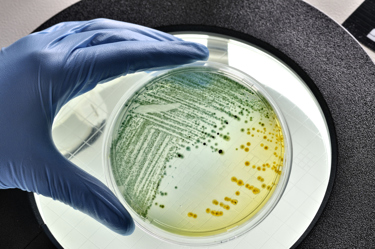UC Irvine Researchers Create E. Coli-Based Water Monitoring Technology

Bacterium used as a live sensor to detect heavy metal contamination
People often associate Escherichia coli with contaminated food, but E. coli has long been a workhorse in biotechnology. Scientists at the University of California, Irvine have demonstrated that the bacterium has further value as part of a system to detect heavy metal contamination in water.
E. coli exhibit a biochemical response in the presence of metal ions, a slight change that researchers were able to observe with chemically assembled gold nanoparticle optical sensors. Through a machine-learning analysis of the optical spectra of metabolites released in response to chromium and arsenic exposure, the scientists were able to detect metals in concentrations a billion times lower than those leading to cell death – while being able to deduce the heavy metal type and amount with higher than 96 percent accuracy.
The process, which the researchers said can be accomplished in about 10 minutes, is the subject of a study appearing in Proceedings of the National Academy of Sciences.
“This new water monitoring method developed by UCI researchers is highly sensitive, fast and versatile,” said co-author Regina Ragan, UCI professor of materials science and engineering. “It can be broadly deployed to monitor toxins at their sources in drinking and irrigation water and in agricultural and industrial runoff. This system can provide an early warning of heavy metal contamination to safeguard human health and ecosystems.”
In addition to proving that bacteria like E. coli can detect unsafe water, the researchers spotlighted the other necessary components – gold nanoparticles assembled with molecular precision and machine learning algorithms – which greatly enhanced the sensitivity of their monitoring system. Ragan said it can be applied toward spotting metal toxins – including arsenic, cadmium, chromium, copper, lead and mercury – at levels orders of magnitude below regulatory limits to provide early warning of contamination.
In the study, the scientists explained that they can apply trained algorithms to unseen tap water and wastewater samples, which means the system can be generalized to water sources and supplies anywhere in the world.
“This transfer learning method allowed the algorithms to determine if drinking water was within U.S. Environmental Protection Agency and World Health Organization recommend limits for each contaminant with greater than 96-percent accuracy and with 92-percent accuracy for treated wastewater,” Ragan said.
“Access to safe water is necessary for the health of people and the planet,” she added. “New technology that can be mass manufactured at low-cost is needed to monitor the introduction of an array of contaminants in the water supply as a critical part of the solution for water security in the face of pollution and climate change.”
Joining Ragan on this project, which was funded by the National Science Foundation, were Hong Wei and Yixin Huang, UCI graduate student researchers in materials science and engineering; Yen-Hsiang Huang, UCI graduate student researcher in civil and environmental engineering; Sunny Jiang, UCI professor of civil and Environmental engineering; and Allon Hochbaum, UCI professor of materials science and engineering.
About UCI’s Brilliant Future campaign:
Publicly launched on Oct. 4, 2019, the Brilliant Future campaign aims to raise awareness and support for UCI. By engaging 75,000 alumni and garnering $2B in philanthropic investment, UCI seeks to reach new heights of excellence in student success, health and wellness, research and more. The Henry Samueli School of Engineering plays a vital role in the success of the campaign. For more information, visit https://brilliantfuture.uci.edu/the-henry-samueli-school-of-engineering/.
About the University of California, Irvine:
Founded in 1965, UCI is a member of the prestigious Association of American Universities and is ranked among the nation’s top 10 public universities by U.S. News & World Report. The campus has produced five Nobel laureates and is known for its academic achievement, premier research, innovation and anteater mascot. Led by Chancellor Howard Gillman, UCI has more than 36,000 students and offers 224 degree programs. It’s located in one of the world’s safest and most economically vibrant communities and is Orange County’s second-largest employer, contributing $7B annually to the local economy and $8B statewide. For more information, visit www.uci.edu.
Source: The University of California, Irvine
